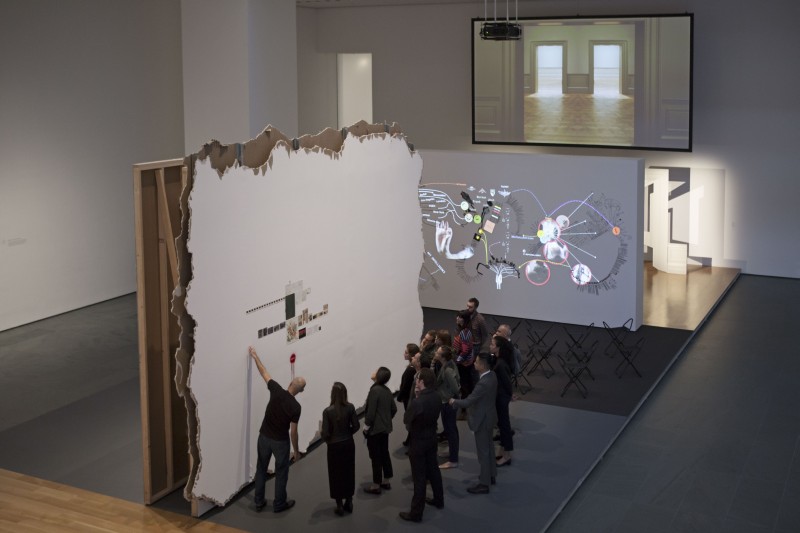 Walid Raad, dressed unremarkably in a black t-shirt and dark blue jeans, speaks to a group of 40 people seated in MoMA’s beautifully open Marron Atrium. Armed with blue headphones, his voice is channeled into our eardrums, drowning out the chatter, laugher and general hubbub that fills one of modern art’s most famous buildings. We sit facing a large white wall with an enormous chart facing us. It is filled with drawings of faces pinging out at us encircled by bright colours, arrows pointing to names of several organisations and lengthy contracts. It’s a busy wall of detailed information.
Walid Raad, dressed unremarkably in a black t-shirt and dark blue jeans, speaks to a group of 40 people seated in MoMA’s beautifully open Marron Atrium. Armed with blue headphones, his voice is channeled into our eardrums, drowning out the chatter, laugher and general hubbub that fills one of modern art’s most famous buildings. We sit facing a large white wall with an enormous chart facing us. It is filled with drawings of faces pinging out at us encircled by bright colours, arrows pointing to names of several organisations and lengthy contracts. It’s a busy wall of detailed information.
Raad tells us that he’s not an actor, that he can get nervous, and may need to move around during his performance. That’s the first of many slippery sentences in which our narrator wrong-foots us. In fact, he is a compelling storyteller who magnetically draws us into his world in an instant. His story begins with a woman called November who contacts him to invite him to be part of the Artist Pension Trust – a scheme for artists to invest their own artwork in order to create a pension for themselves. As he begins to investigate the scheme it leads him on an intriguing story of investors who have all served in the Israeli army and he questions his safety as a Lebanese man if he were to invest his art within this worldwide system. This kicks off an hour-long monologue in which five art-works are used as props to investigate the blurred lines between artistry, commerce and war.
We move between five areas within the atrium. Projections of empty art gallery walls create an eerie backdrop for what appears to be a factual account of how the Arab world is building a new empire of art galleries and theatres, built by ‘starchitects’. But who are this new, giant Guggenheim Museum and Louvre Museums in Sharm Al Sheik for exactly? Raad suddenly becomes a normal Arabic man, ten years from now, who walks to the entrance of the newly opened gallery wearing a black T-shirt and dark blue jeans and is almost-violently refused entry. It’s a quietly unnervingly image that lingers uncomfortably in my mind.
The third section utilises his celebrated work The Atlas Group (1989 – 2004), which was inspired by his research into the Lebanese Civil War in which 100,000 people were killed. Having been pestered for years by a curator (could this be true?) he finally agrees to display his work in Lebanon but when he arrives to see it hung, everything has shrunk to 1/100 of its size. It’s a miniature. Someone must be playing a joke on him, or is he having a psychotic episode?
The entire performance has this nightmarish, slippery quality that experiments with narrative – what is true? What should we believe? We are entirely invested in Raad’s narrative until he slides in a quietly dark image, or an unquantifiable ‘fact’ – he tells us with great sincerity that all of the colours framed on the wall have disappeared, yet we can see them. And he keeps us smiling – he’s funny, charming, convincing. As we roam the artworks alone after he’s left we’re faced with our own reflection in four large frames of grey. Who are we within all of these forces: the arts, the economies that celebrate and fund these arts, and the wars taking place with faces that we never see. It’s a powerful performance, whose force sneaks up on you, and lingers in the mind.
